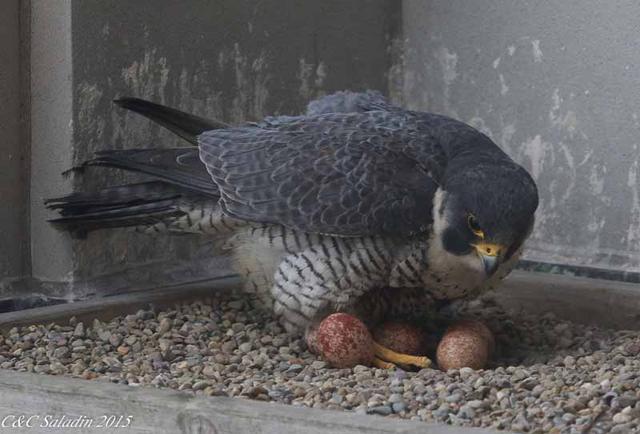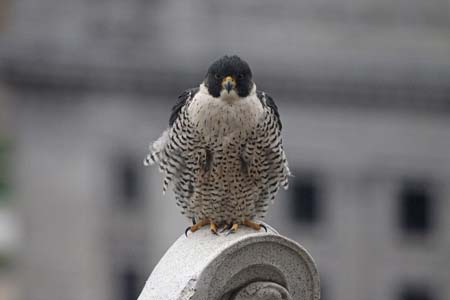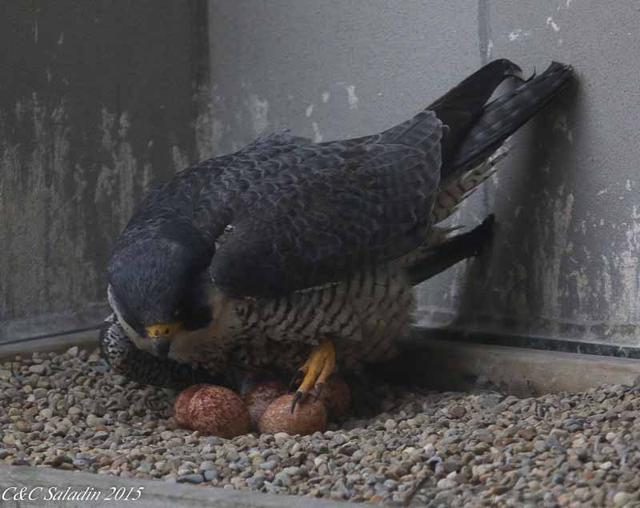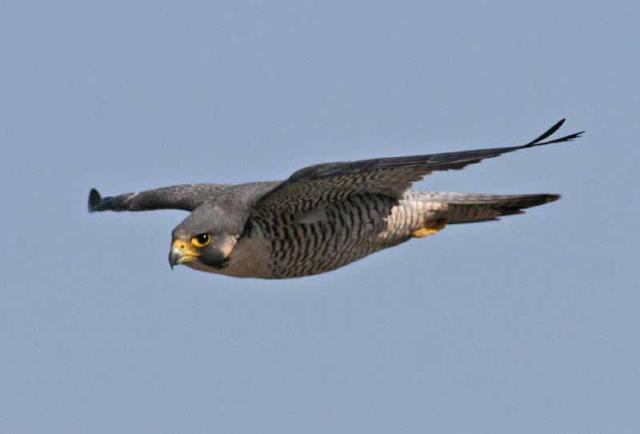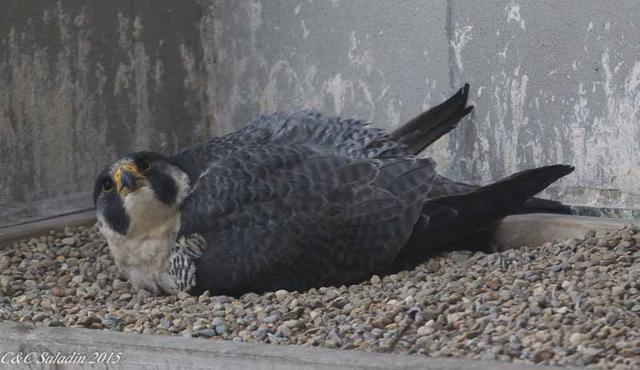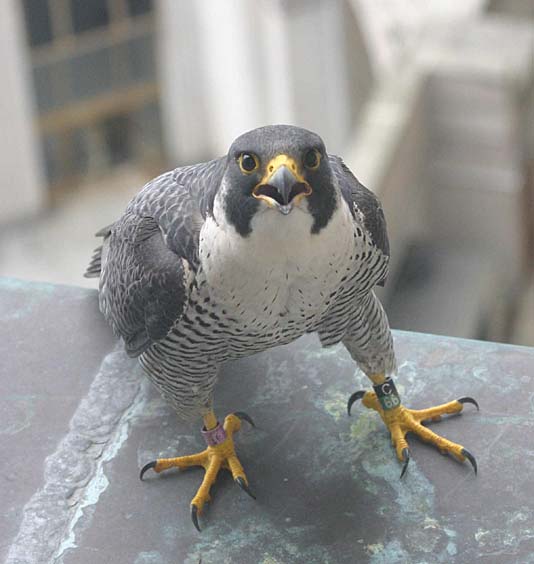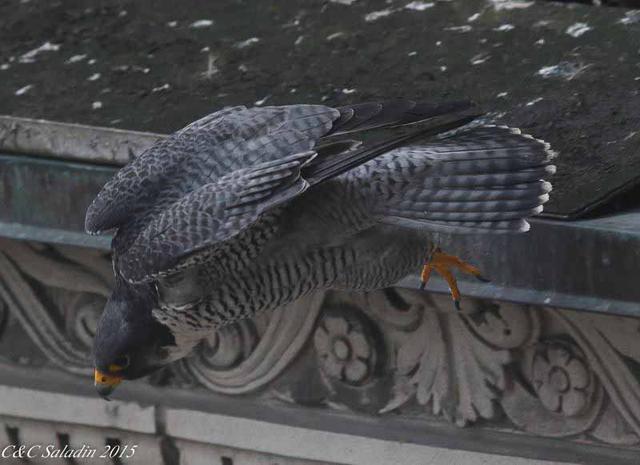FALCON FLASH
Dateline: Cleveland, Ohio
April 16, 2015
Click here to read what happened earlier
See if you can find these cities on a map. Can you figure out how far Boomer and Newton had to fly to meet in Cleveland, Ohio?
Mrs. Saladin visited the nest recently and reports, “Felt like a mini-break-through today with Newton, as after initially focusing on me at the window she seemed undeterred. Perhaps she is beginning to realize that window watchers don't pose a threat to her, as she was non-reactive even as I removed the blind and even when I checked her out in the closer window. She was incubating the whole time I was there, making some soft "chipping" sounds and tracking Boomer's movement as he flew in……” Here she is watching Boomer.
In the following video you can see a previous male at this nestsite perform the very important task of egg turning: http://s662.photobucket.com/user/CnCSal/media/Rangerincubate.mp4.html
The World Center for Birds of Prey suggests, “You could dissect a chicken egg to reveal the basic components of the egg. Most ornithology books will explain the anatomy of the egg. A store bought egg will do. The eggs are not fertilized,so may not show all components of the egg. Break the shell open gently and pour onto a smooth surface. You will also want to look at the eggshell, so don't destroy it. If you have a dissecting microscope you could see the pores on the outside of the eggshell. This is where gas exchange occurs. Oxygen goes in and carbon dioxide goes out. Have fun."
For a diagram of a chicken egg, which shows the basic parts of a bird’s egg, go to: http://www.sites.ext.vt.edu/virtualfarm/poultry/poultry_eggparts.html
If you have been watching Newton and Boomer, you may have wondered about their lives. Because the peregrine falcon was on the List of Endangered Species for 40 years, many birds are banded and their life histories are known. Newton hatched in 2001 at the Kewaunee Nuclear Power Plant in Carlton, Wisconsin. The nest box was on the ledge at the base of the containment dome. Her band numbers are b/g 18A.
Then she watched from the edge of the tray while softly vocalizing to Boomer before taking back over.
Newton does most of the egg-sitting but Boomer relieves her from time to time. In this picture Boomer departs after his turn…..
Newton and Boomer have been very busy incubating their large “clutch” of 5 eggs. In fact, it’s hard to keep them all under one falcon…..
If you have been monitoring the FalconCam archives, you may have noticed that Newton or Boomer turn and rearrange their eggs about once every hour. (Click on the FalconCam Archives, located under each picture on the front page at http://www.falconcam-cmnh.org/news.php in order to see pictures of all the day's activities).
The World Center for Birds of Prey in Boise, Idaho explains this interesting bird behavior: "Birds rotate their eggs to keep the eggs evenly warm or cooled (depending on weather). If the clutch is large, then the eggs on the outside are moved into the center of the clutch where the temperature maybe a few degrees higher. Eggs are also rotated to prevent the developing embryo from prematurely sticking to the inner membrane of the egg. If the egg stays in one position for too long, then the embryo can stick to the inner membrane. This
may cause the embryo to develop or hatch improperly”. Former nest monitor, Mr. Scott Wright, adds that at the end of egg-turning: “the female will pick up stones from the box and drop them down right in front of her into the scrape. This replaces the stones that are pushed away when turning the eggs”. Here is Newton rearranging her eggs.
Boomer was hatched in Columbus, Ohio in 2008. We know this because of his leg band, C/66.
Incubation is the period of time when the eggs are covered by the parents to keep them warm and dry as the chicks develop within the eggs. Mr. Harvey Webster, Director of Wildlife Resources at the Cleveland Museum of Natural History, tells us that in heavy rain, and sometimes even in snow, “it is a tribute to the parents that they can create a warm and dry sanctuary…. with their own bodies…… In fact the temperature closest to the brood patch on the female’s abdomen might be close to 100 degrees F. The brood patch is featherless and highly vascularized to provide maximum surface area for heat transfer”. Look carefully at the following picture and you can see 2 brood patches on a female’s abdomen.
The Peregrine Fund, located at the World Center for Birds of Prey, led the way to save the species peregrine falcon. Falcon lovers owe our gratitude to this organization, as well as many others, for the survival of the peregrine falcon in North America. Today they continue working to save birds of prey species around the world. Visit them at: http://peregrinefund.org/
To watch the falcons live go to: http://www.falconcam-cmnh.org/news.php
Our thanks to the Cleveland Museum of Natural History for sponsoring the FalconCams.
Photos and video are courtesy of volunteer peregrine nest monitors, Mr. and Mrs. Saladin
Click here to read what happened next

